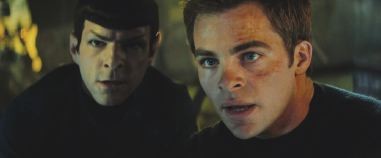Star Trek

A riveting sci-fi adventure, Star Trek is the first of the summer blockbusters that audiences can truly care about. Its action is rooted in feeling rather than gimmickry.
Screenwriters Roberto Orci and Alex Kurtzman take the Star Trek narrative back, one might say, to first principles. The plot presents the two beloved heroes of the original TV series as young men dealing with the repercussions of childhood traumas. James T. Kirk (Chris Pine) grew up without a father. His dad had taken over a Starfleet ship when its commander walked into a confrontation with a ruthless villain named Nero (Eric Bana). Kirk Sr. managed to save everyone on board, including his own pregnant wife, but had to sacrifice his own life to do so. (Kirk’s relationship with his father is changed from the one set out by Gene Roddenberry in the original TV show.)
Kirk the son, belligerent and reckless, misspends his youth until Captain Pike (Bruce Greenwood) inspires him to enlist. Spock (Zachary Quinto), the son of a Vulcan father and a human mother, struggles with prejudice on his home planet as well as with his mixed legacy (reason from his father, emotion from his mother). The two young men wind up together on Pine’s ship, where initially they hate each other. Part of the movie’s suspense is waiting to see how they will develop into the friends we know they will become.
The layered story rests on the device of time travel. Nero is a visitor from the future; he targets both Kirk and Spock (and their families) to wreak vengeance for events that have not yet occurred, and in doing so he upsets the time-space continuum.
Bana is perfectly adequate under his make-up, but Nero isn’t the most memorable villain in the history of Star Trek; he’s not in the same class as Ricardo Montalban’s Khan in Star Trek II: The Wrath of Khan. But the tale spun around Nero is so compelling that the movie can stand his being compared to Khan. And the director, J. J. Abrams, who created Alias and Lost for television, employs his talent for emphasizing emotional complications. Pine uses a combination of clarity and humor to delineate the levels of Kirk’s personality; it’s a very smart action-hero performance.
The film pivots, however, on the subtly and complexity of Quinto’s portrayal of Spock (a pleasant surprise if you’ve seen Quinto chew the scenery on the small screen as the serial killer Sylar in Heroes). The time-travel plot allows Leonard Nimoy, who created the role of Spock, to make an appearance too, for reasons that will make sense to sci-fi aficionados. It’s a treat to see him; the problem is that Quinto is easily the superior actor.
Even casual Star Trek watchers will enjoy hearing the movie’s young actors match up vocally with the actors in the original version of the 1960s. Karl Urban, Simon Pegg, Anton Yelchin and John Cho take up the by-now archetypal roles of Bones, Scotty, Chekov and Sulu, and the stunningly beautiful Zoë Saldana is Uhura, who in this entry is romantically linked to Spock (and is the only person who seems to understand him besides his mother, who is played by Winona Ryder in a cameo). Salty, plainspoken Bones is Kirk’s first friend; they go through the Starfleet Academy together. Chekov and Sulu, like Uhura, show up on Pine’s ship—which is, of course, the Enterprise. Orci and Kurtzman use a little more invention to introduce Scotty and his celebrated beaming-up technology.
Abrams’s only mistake is that he shoots the fight scenes so tightly that the action isn’t clear. But he knows how to take the full emotional measure of what the screenwriters have supplied. The opening scenes, which detail Kirk Sr.’s heroic sacrifice, prepare us for a more wrenching sequence when Nero turns his fury on Spock’s home planet. This is the centerpiece of the movie—and where Quinto displays his skill at revealing Spock’s feelings even as he represses them. Here and elsewhere, Abrams’s staging and Daniel Mindel’s cinematography emphasize the handsome production design by Scott Chambliss. Star Trek is the ideal summertime entertainment.





